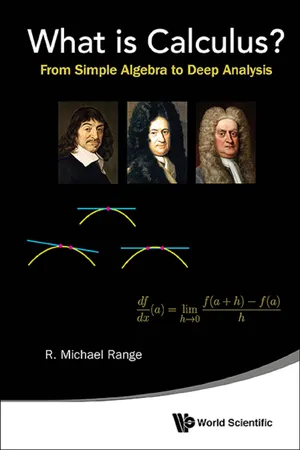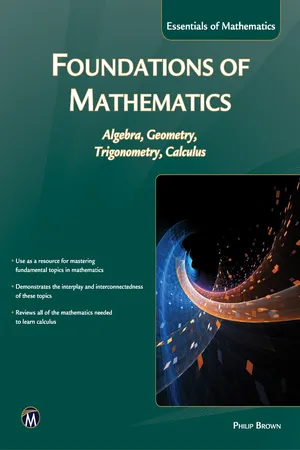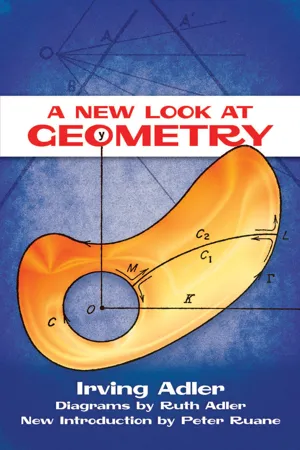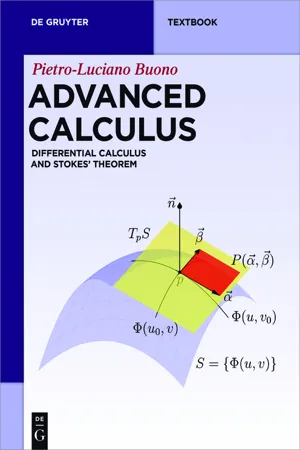Mathematics
Tangent Lines
Tangent lines are straight lines that touch a curve at a single point, without crossing it. They are used in calculus to find the slope of a curve at a specific point, which is important for determining the rate of change of a function. The slope of a tangent line is equal to the derivative of the function at that point.
Written by Perlego with AI-assistance
Related key terms
7 Key excerpts on "Tangent Lines"
- eBook - ePub
What is Calculus?
From Simple Algebra to Deep Analysis
- R Michael Range(Author)
- 2015(Publication Date)
- WSPC(Publisher)
analytic version of calculus based on limits, and it will allow us to focus from the very beginning on the principal new ideas in their natural context, where they truly are indispensable.We shall freely use standard concepts and formulas familiar from typical high school geometry and algebra courses, including, for example, the slope of a line. The most important background material will be thoroughly reviewed in Chapter I , in a form that will include and highlight the critical concepts that are necessary to understand the new central ideas related to limits. The reader is encouraged to refer to appropriate sections in Chapter I as needed in order to follow the discussion in the Prelude.2 Tangents to Circles
The construction of Tangent Lines to circles, parabolas, and similar classical curves has a long history, going back to Euclid (4th century B.C.), Apollonius (3rd century B.C.), and other Greek geometers over 2300 years ago. In antiquity a tangent was defined as “a line which touches a curve but does not cut it” [Victor J. Katz, A History of Mathematics , 3rd. ed., Addison-Wesley, New York 2009, p. 120]. The tangent appears to fit the curve near the point of contact in an optimal way. The situation is particularly simple for a circle C , where the tangent at a point P on C is that unique line that is perpendicular to the radial line connecting P to the center of the circle. In general, the line that is perpendicular to a tangent at a point P on a curve is called the normal to the curve at P . Circles are special, since all normals go through the center and consequently are easy to draw for any point P on the circle. However, when one considers more general curves, there is no obvious way to construct normals and/or tangents. Finding either one immediately determines the other.1 The main problem then is to turn the intuitive but vague ancient idea of “tangent” recalled above into a precise definition that can be used to identify tangents and determine their slopes for arbitrary curves. Intuitively, we recognize that (in a small neighborhood) a tangent intersects the curve under consideration only at one point P —the point of tangency —while most small perturbations (i.e., changes) of the tangent will intersect the curve at two distinct points close to P . (See Figure 2 - eBook - ePub
- Gary Bronson, Richard Bronson, Maureen Kieff(Authors)
- 2021(Publication Date)
- Mercury Learning and Information(Publisher)
= 1.The darker line shown in Figure 5.7 is formally known as a tangent line. 1 It is the slope of the tangent line at a point on a curve that is defined as the function’s instantaneous rate of change at that point. For each point that has a tangent line then, it has a defined instantaneous rate of change.Two important observations are relevant here. The first is that a tangent line may not exist at all points on a curve. When this is the case, the instantaneous rate of change is not defined for the function at these points. Cases, where this occurs, are presented at the end of the next section.The second observation is that the instantaneous rate of change can, and almost always does, differ at different points of a function. Thus, because there is an infinity of points on a curve, and graphically determining the tangent line’s slope for even a few of these points becomes unrealistic. For example, consider Figure 5.8 , where two Tangent Lines are shown – one at x = − 1.3 and one at x = 2. It is the slope of each of these lines that is the instantaneous rate of change of the function at the points shown.Fortunately, there is a mathematical procedure for easily determining slopes of all Tangent Lines, where they exist, at all points on the curve. The basis for this procedure is as follows.FIGURE 5.8 Instantaneous rates of change may vary at different input values along the curve.As previously shown in Figure 5.7 , as the intervals for which the average rates of change are calculated get smaller and smaller, the slopes of the secant lines for these intervals approach the slope of the tangent line. To obtain a mathematical formula for this procedure, let point A in Figure 5.7 has coordinates (x 1 , y 1 ) and point D coordinates (x 1 , y 1 ), as shown in Figure 5.9 . - eBook - ePub
Foundations of Mathematics
Algebra, Geometry, Trigonometry and Calculus
- Philip Brown(Author)
- 2016(Publication Date)
- Mercury Learning and Information(Publisher)
t = 2 is 4 m/s.FIGURE 8.13. A car approaching an intersection.In a certain sense, calculus is a science of approximation. The reason for this begins with the observation that a tangent line is a good approximation to a function close to the point of tangency. Indeed, this was the criterion used in section 8.2.2 to define the tangent line.Now, recall formula (8.8), which is the equation for the tangent line if f(x) is differentiable at x = a and the point of tangency is (a, f (a)). If x is close to a (here, “close” just means close enough for the purpose in mind), then the factor (x − a) can be abbreviated by Δx, meaning a small increment in the dependent variable y. The equation for the tangent line can thus be expressed as Δy = f′(a)Δx. This states that the increment in y along the tangent line is proportional to the increment in x according to the factor f′(a). The actual amount by which the function f changes corresponding to the increment Δx is f(a + Δx)− f(a) and this is approximately the value Δy. Another way to write this approximation isThis is shown in figure 8.14 .FIGURE 8.14. Linear approximation of a function.REMARK 8.7.1. The equation Δy = f′(a) Δx or (with x replacing a) Δy = f′(x) Δx resembles the equivalence We do not regard as a fraction in the usual sense; however, in the advanced mathematics of tensor algebra, expressions such as dy, df, or dx are called differential forms, and they are given a precise meaning. We cannot explain this in detail here, but we will regard the equation dy = f′(x)dx - eBook - ePub
Optimization with LINGO-18
Problems and Applications
- Neha Gupta, Irfan Ali(Authors)
- 2021(Publication Date)
- CRC Press(Publisher)
It differs at different points on the curve. The slope of a curvilinear function at a given point can be measured by the tangent to the function at that point. A tangent line is a straight line that touches a curve at only one point. Steps to find a tangent to the curve y = f (x) at point (x 0, y 0) are as follows: calculate the function f (x 0) and f (x 0 + h). calculate the slope, m = lim h → 0 f (x 0 + h) − f (x) h if the limit exist, the tangent line will be found as y = y 0 + m (x − x 0) Example 14 Let a curvilinear function y = f (x) = 2 x 2, then the slope of the function. is m = lim h → 0 2 (x + h) 2 − 2 x 2 h = lim h → 0 2 (x 2 + h 2 + 2 h x) − 2 x 2 h o r m = lim h → 0 4 h x + 2 h 2 h = lim h → 0 (4 x + 2 h) take limit h → 0, then m = 4 x. Noted that, the value of the slope m depends on the value of x chosen. At x = 1, slope m = 4; at x = 2, slope m = 8 and so on. Example 15 Find the tangent line for y = mx + b at the point (x 0, mx 0 + b). f (x 0) = mx 0 + b and f (x 0 + h) = m (x 0 + h) + b, hence, lim h → 0 f (x 0 + h) − f (x 0) h = m Therefore, the tangent line at the point (x 0, mx 0 + b) is y = mx + b. It shows that the line y = mx + b is its own tangent at any point (x 0, mx 0 + b). 1.16 Vertical Tangent Let the curve y = f (x) have a vertical tangent at the point x = x 0 where lim h → 0 f (x 0 + h) − f (x 0) h = ∞ or −∞ Example 16 Let the curve y = x 1/3, have a vertical tangent at x =. 0 lim h → 0 f (0 + h) − f (0) h = lim h → 0 h 1 / 3 − 0 h = ∞ 1.17 Derivative of the function The function f ′ is the derivative of the function f with respect to the variable x. The f ′ value at f ′ = lim h → 0 f (x + h) − f (x) h, provided the limit exists. If f ′ exists, then f has a derivative at x. Example 17 Let f = x x − 1 and f (x + h) = x + h x + h − 1 and hence lim h → 0 − 1 (x + h − 1) (x − 1) = − 1 (x − 1) (x − 1). The slope will be -1, provided − 1 (x − 1) 2 = −1 ⇒ x = 2 or x = 0. Example - eBook - ePub
- Christina Pawlowski-Polanish(Author)
- 2021(Publication Date)
- Barrons Educational Services(Publisher)
Chapter 4Applications of Derivatives
Knowing how to calculate the derivative of a function and what it represents leads to some very useful applications of derivatives. Equation of a Tangent LineDiscovering that the derivative of a function at a value represents the slope of the tangent line can be extended further to writing the equation of a tangent line to a curve at a point. There are a few ways to write the equation of a line, including the slope-intercept form, y = mx + b, and the point-slope form, y – y1 = m(x – x1 ). Typically, you will be given the equation of the function and the x-value at which the tangent line and the curve intersect. With this given information, using the point-slope form to write the equation of a tangent line will be more convenient.Writing the equation of a tangent line is painless. There are three steps to follow.Step 1: Find the coordinates of the point of tangency; these are the x- and y-coordinates of the point of intersection of the tangent line and the curve.Step 2: Find the slope of the tangent line by calculating the derivative at the point of tangency.Step 3: Substitute the point of tangency and the slope of the tangent into the point-slope form of a line.Example 1:Given the function y = x3 , write the equation of the tangent line to the curve at x = 2.Solution:Step 1: Find the coordinates of the point of tangency.Given y = x3 and x = 2:y = (2)3 = 8The point of tangency is (2, 8).Step 2: Find the slope of the tangent line.Calculate the derivative:Evaluate the derivative at x = 2:This represents the slope of the tangent line at x = 2.Step 3: Use point-slope form, y – y1 = m(x – x1 ), to find the equation:Point: (x1 , y1 ) = (2, 8)Slope: m = 12y – 8 = 12(x – 2) or y = 12x – 16PAINLESS TIPUnless otherwise stated, the equation for a tangent line can be left in point-slope form. Since the point of tangency will very rarely be a y - eBook - ePub
- Irving Adler, Ruth Adler, Peter Ruane(Authors)
- 2013(Publication Date)
- Dover Publications(Publisher)
9The Calculus and Geometry
Curved Figures
The axioms of Euclidean plane geometry express properties of straight lines and of figures, such as angles and triangles, that can be made from straight lines. However, there are important figures, such as the conic sections, which consist of curved lines. This fact confronts the mathematician with a challenging question: How can you use axioms about straight line figures to draw valid conclusions about curved line figures? The basic answer to this question was provided by the method of exhaustions of Eudoxus by which a curved line figure is obtained as the limit of a sequence of straight line figures that give better and better approximations to it. The elaboration of this method over the centuries ultimately led to the development of the specialized techniques of the calculus and the branch of geometry called differential geometry in which these techniques are employed.In this chapter, without becoming involved in the specialized techniques of the calculus, we shall explain the geometric meaning of its basic concepts. Then we shall derive in a non-technical manner the concept of the curvature of space. Our reward will be a deeper understanding of the significance of the three geometries, Euclidean, hyperbolic, and elliptic, that emerged from the study of the theory of parallels.Slope and Derivative
The fundamental problem of the differential calculus may be expressed geometrically as that of finding the slope of a straight line that is tangent to a given curved line at a given point. To solve this problem we first introduce a pair of rectangular coordinate axes OX and OY in the plane. Let P1 be the given point on the curve, and let P1 T be the tangent to the curve at P1 . Let P2 be another point on the curve, near P1 and draw the straight line P1 P2 . A line like P1 P2 which passes through two points of a curve is called a secant. If P2 is allowed to move toward P1 the secant P1 P2 rotates around the point P1 and approaches the position of the tangent line P1 T. That is, P1 T is the limit approached by P1 P2 as P2 approaches P1 . Consequently the slope of P1 T is the limit of the slope of P1 P2 as P2 approaches P1 - eBook - ePub
- Pietro-Luciano Buono(Author)
- 2016(Publication Date)
- De Gruyter(Publisher)
3Tangent Spaces and 1-forms
We define the concept of tangent space using specific examples: curves, the spaces ℝn and finally two-dimensional surfaces given by z = f (x, y ). The tangent space to a geometric object is an important topic in advanced calculus and differential geometry. The second part introduces a formal definition of differential and the construction of the so-called 1-forms.3.1Tangent spaces
We begin by discussing how Tangent Lines lead to tangent space and build more general tangent spaces for ℝn and surfaces.3.1.1From Tangent Lines to Tangent Spaces
The previous section shows how to determine the tangent line to a curve C at some point p ∈ C using the derivative of a vector function r (t ) defining C . The goal of this section is to extract the vectors which lie on the Tangent Lines so that we can add them together without leaving the tangent line.Example 3.1.1. Consider the plane curve C given by x (t ) = t 2 , y (t ) = 1 − t for t ∈ [0, 1]. We obtain the tangent line equation at t = 1/ 2 by the formulawhere s ∈ ℝ is a parameter. The tangent line is not a subspace, if one adds two elements of 𝓁 (s ), then the result is not in 𝓁 (s ) anymore:However, if we decide to fix the base point (x (1/ 2), y (1/ 2)) and only add the parametrized part and add the base point after, this leaves us on the tangent line:and so (x (1/ 2), y (1/ 2))+(s 1 +s 2 )(1, −1)With this in mind, we can now introduce the concept of tangent space, which is a crucial aspect of advanced calculus and of differential geometry in general.is a point of the tangent line. See Figure 3.1 for an illustration.Definition 3.1.2. Let C be a smooth space curve (in ℝn ). If p∈ C then the tangent space of C atp, denoted by Tp C, is the set of all vectors tangent to C at the point p.Fig. 3.1. Curve C given by r (t ) = (t 2 , 1 − t ) and the tangent line at p = (1/ 4, 1/ 2). The orientation is from (0, 1) to (1,
Index pages curate the most relevant extracts from our library of academic textbooks. They’ve been created using an in-house natural language model (NLM), each adding context and meaning to key research topics.






